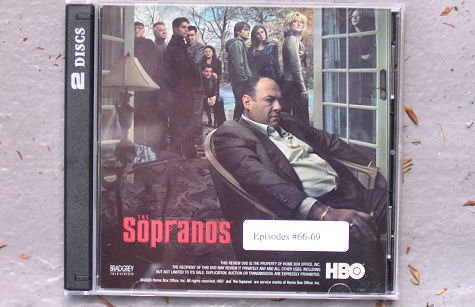The Spirit of Radio
Robert Altman’s A Prairie Home Companion (Picturehouse, 6.9), based on Garrison Keillor’s radio show with a script by Keillor, is a backstage look at the goings-on during the final broadcast of America’s most celebrated radio show.
The film played Friday night (3.10) at the kickoff of South by Southwest in Austin, and Moises Chiullan, author of HE’s “Arthouse Cowboy” column, was in the audience with his video camera. And he’s sent along some thoughts. Which I’ve refined and reshuffled to some extent.
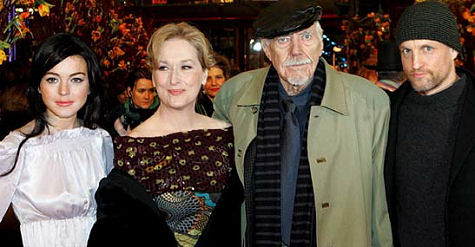
Prairie Home Companion‘s Lindsay Lohan, Meryl Streep, Robert Altman and Woody Harrelson…not at South by Southwest but last month’s Berlin Film Festival
Altman always lets his actors cut loose according to their own whims and improvs, and the word from February’s Berlin Film Festival, where A Prairie Home Companion had its world premiere, is that the cast — Kevin Kline, John C. Reilly, Meryl Streep, Lily Tomlin, Tommy Lee Jones, Woody Harrelson, Garrison Keillor, Lindsay Lohan, Virginia Madsen — has a good time with it.
I’ll get right to Moises in a second, but first a question that’s been bothering me. Why is it for the last several years that the PHC show and Keillor’s name, even, seem to constantly be about finality, signing off, winding down, bidding farewell? What’s wrong with keeping on and putting more wood on the fire? Is this some kind of death trip?
The flm’s highlights, Chiullan says, “include the radiant singing voice of Meryl Streep, the sharp and acerbic one-liners, and the recalling of the golden age of radio throughout the script.”
The narrative “is part radio show, part real, and the structure is unconventional, to say the least. But the combination works.
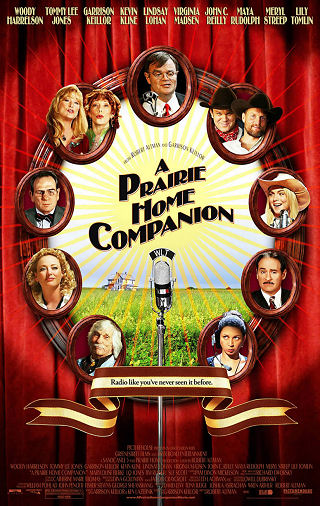
“The radio setting and the overlapping, Mamet-esque rambling from various characters immediately brought to mind a Mamet play called The Water Engine. That play began as a radio drama and shifted back and forth from the studio to a conventional stage play in much the same way that Keillor’s characters like Guy Noir (Kevin Kline) and the Dangerous Woman (Virginia Madsen) interweave into the lives of these ‘real’ people performing in a fictionalized version of A Prairie Home Companion.
“Altman’s film is conscious of the fact that radio variety programs have been out of style for decades, as this one always has been, but that’s not all of the point here. The film is basically saying that the passion and humor that used to be is not so out-of-touch as some of us might think.
“One of the first striking things about A Prairie Home Companion is the new, animated, and really snazzy Picturehouse logo.
“The film opens in Mickey’s Dining Car, with voice-over narration by Kline’s Guy Noir. Being a longtime listener of the radio show, I was impressed how undistracting it was having another voice saying the lines usually spoken by Keillor.
“John C. Reilly and Woody Harrelson bounce off one another so well it’s remarkable no one has used them together previously. Their song about bad jokes absolutely kills. There were moments of suspension and then uproarious laughter related to duct tape, Descartes, and Texans who ‘talk funny and whose eyes don’t focus.’
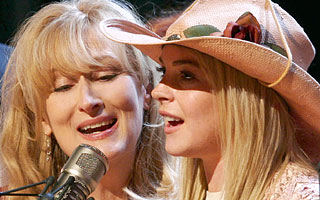
Meryl Streep, Lindsay Lohan
“And Streep lights up the whole room. She’s so ‘on’ and ‘in’…and continues to surprise me every time. There isn’t a moment in the film in which I remotely doubted any of her motivation or found her over-the-top.
“Streep and Lily Tomlin are just as well-matched as Harrelson and Reilly. Their interplay and overlap will be the subject of many rewatchings, since there was no way to absorb it all last night through the laughter.
“Maya Rudolph plays the Stage Manager from Noises Off!-type part well, the sensible link in a chain of chaos, and Tommy Lee Jones provides a wonderfully contrasting role compared to that of his recent turn as Pete in The Three Burials of Melquiades Estrada.
“Even Lindsay Lohan shows some decent chops as Streep’s dismissive and withdrawn poet-daughter, Lola.
“So much of the film is symbolic and semiotic in its delivery, and it hits the right notes the whole way through, crackling with electric bits of wit and passion throughout.
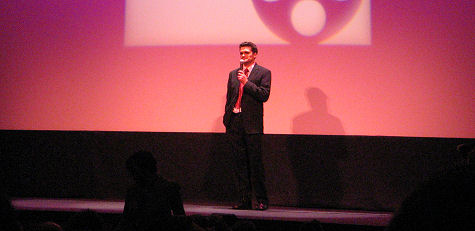
South by Southwest director Matt Dentler doing the introductions at Friday night’s event (3.10.06)
“Screenwriter Ken LaZebnik was at last night’s screening, and I wish I could have shook his hand or bought him a beer or six. Few films talk about mortality as much as Prairie Home does and end up reaffirming your desire to get up the next day and change the world somehow rather than consider giving up.”
The video footage is of South by Southwest honcho Matt Dentler introducing Reilly and LaZebnik and bringing them to the stage.
The Less Bondy…
…Daniel Craig turns out to be in Casino Royale (Columbia, 11.17), the better for the franchise and movie culture. Okay? It’s an excellent thing that the fans of the old smoothie-type Bond — tuxedos, constant cocksman, shaken-not-stirred — are giving it to Craig for stepping into his shoes. In a way, their scorn is a badge of honor.
Advocates of sticking with old-school models just because they’re old-school models are never worth anyone’s time. They’re like the old-school Communists who tried to unseat Boris Yeltsin….like the people who said no to Elliot Gould’s Philip Marlowe in The Long Goodbye and that only a dick in the Humphrey Bogart mode would do.
Read Ian Fleming’s “Casino Royale” and Craig will pop into your mind. And good for Paul Haggis and Martin Campbell for keeping that ballsy torture scene (no pun intended).

Daniel Craig in a new still from /Casino Royale
Out with the old and in with the new blood, and good for Craig not being quite six feet tall and having blond hair, ice-blue eyes and a boxer’s nose.
I still haven’t thrown out my suggestion for getting rid of 007 producers Barbara Broccoli and Michael Wilson by kidnapping them, flying them to Thailand and keeping them in a deluxe-accomodation prison there for the next 20 years. That aside, Casino Royale has my vote just for the sake of agitating any and all fans of Diamonds are Forever and On Her Majesty’s Secret Service.
But the webmaster at Sony should junk that ancient Dr. No “James Bond theme” music that plays when you click on the Casino Royale site. Talk about sending the absolute worst message imaginable.
Marquee Value
It costs time and money, I’m sure, but how technically difficult can it be to show decent, convincing footage of what Times Square looked like in 1955? Whatever it required, it was too much for director Mary Harron when she was assembling The Notorious Bettie Page (Picturehouse, 4.14).
This is one of those technical-obsession pieces that I write every so often, and it shouldn’t be taken as an early volley against Harron’s film. I’m just one of those guys who can’t help cringing when directors of period films get Manhattan movie- theatre marquees wrong. This is Harron’s small but significant botch in the opening seconds of her ’50s-era biopic.
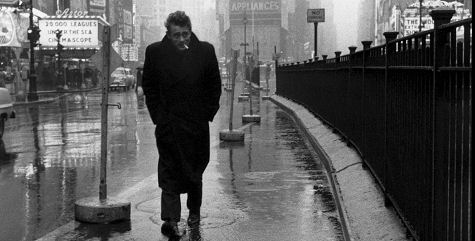
This famous shot of James Dean in Times Square in 1954 uses roughly the same vantage point as the footage used by director Mary Harron in the opening seconds of The Notorious Bettie Page
She starts with black-and-white newsreel footage of Times Square from a high-up perspective with titles proclaiming “New York City, 1955.” Then a second, lower- angled shot of Times Square from an approximate vantage point of 44th Street, looking north on Broadway. And on the left side we can see the marquee of the legendary Astor threatre, which has the names “Cary Grant,” “Myrna Loy” and “Melvyn Douglas” brightly displayed.
Of course, there’s only one film in which these three actors appeared together — Mr. Blandings Builds His Dream House, which was reviewed by New York Times critic Bosley Crowther on March 26, 1948. In its heyday the Astor was very strictly a first-run venue, which means, obviously, that Harron’s footage was shot in ’48. And that means she has to go stand in the corner and face the wall.
If I hadn’t brought this up maybe 25 or 30 people in the face of the earth might have spotted this mistake — I realize that. This is the sort of nitpicky issue that flabby- bellied movie buffs with no lives get incensed over. (Although I’d like it understood I’m not coping with either one of these traits.)
Thing is, I respected Harron’s last film, American Psycho, in part for how well she captured those late-1980s details, like hot shots talking in expensive restaurants on U.S. Army walkie-talkie four-pound cell phones.
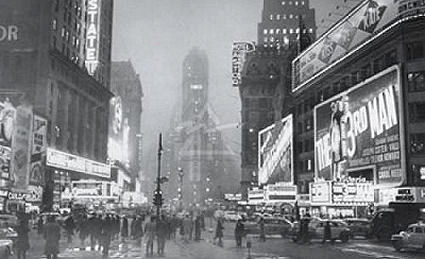
Famous idiot photo titled “Times Square 1942,” with contradictory evidence screaming at you from three theatre marquees.
I was therefore amazed that Harron had managed to duplicate one of the most famous photo-caption blunders in world photographic history. I’m speaking of that stupid photo you can find online by Googling “New York 1942” and then “images.” You know…the one that clearly shows two 1949 films playing side by side — Carol Reed’s The Third Man and William Wellman’s Battleground — at the Astor and the Victoria theatres?
If Harron had wanted to get her footage right, all she needed to do was hire some NYU CG geek to paste fake marquee letters on the Astor marquee spelling out any 1955 release — The Rose Tattoo, East of Eden…whatever. (I could let Harron slide if the substitute film didn’t actually show at the Astor — there’s a limit to this kind of obsessiveness.)
This would have been a simple cut-and-paste job by today’s standards. Harron’s Astor marquee Blandings footage lasts maybe two or three seconds, not long enough for the eye to notice any technically crude touches. It would have been so simple for some kid to come in and fix it with the most rudimentary software on an Apple laptop.
If it’s any comfort to Harron, Billy Crystal made the same error in his HBO Roger Maris-and-Mickey Mantle film 61. He used a snippet of color footage of Times Square with the wrong film, Mutiny on the Bounty, playing at Leow’s State in the summer of 1961, even though this MGM Marlon Brando film opened in November 1962.

East side of Times Square between 46th and 47th Street in 1962
On the other hand, Mike Nichols got it just right in a scene he shot for Carnal Knowledge (1971) showing Jack Nicholson and Ann Margret in the back of a cab moving through Manhattan. Nichols used rear-projection color footage through the cab’s rear window that caught a glimpse of The Four Horseman of the Apocalypse playing at Leow’s State.
An inauspicious peek at a marquee touting this lousy Glenn Ford film, reviewed by Crowther in March 1962, told film buffs exactly when Nicholson and Ann-Marget’s budding romance was happening, and because it didn’t argue with any title cards (which Nichols didn’t use anyway) the shot was perfectly fine.
Brubaker Tribute
Over 450 Brokeback Mountain loyalists under the leadership of the “Ultimate Brokeback Forum” are incensed over last Sunday’s Best Picture defeat, and have managed to fund an ad in Daily Variety that will drive their point home.
Peter Greyson, who has chaired the campaign at the Dave Cullen site, says that over $17,500 dollars has been raised from around the world, and that the full-page ad [see below] will run in Friday’s issue of Daily Variety.
“The circulation people there tell us the issue is already sold out because the demand is so very high,” Greyson just told me (5:21 pm Eastern). “We just hope the people at Focus and all those involved with the film will see our tribute to them. It has been an all-volunteer effort involving over 200 volunteers.”

A friend from the N.Y. Daily News has sent me the page with all the information, links, visuals, comment. The ringleaders besides Greyson and author/journalist Dave Cullen are John Wells and Linda Andrews.
Their ad will basically be an emotional salute to Ang Lee’s film in the manner of the final moments in Stuart Rosenberg’s Brubaker (1980).
I’m speaking of the finale when prison convicts start slowly clapping in tribute to Robert Redford’s character, who’s been fired as warden for being too much of a political troublemaker. You may have failed in a political way, the cons are saying, but you’re made of the right stuff and we respect what you did.
Gardener in Nairobi
“More than six months after its U.S. release (and two days before Rachel Weisz took home an Oscar), The Constant Gardener finally opened in Kenya, the country which provided the majority of its locations.
“The Fernando Meirelles film opened to almost no public fanfare, and is now showing on exactly one screen in exactly one theater (alongside Zathura and Derailed), in a Nairobi suburb mostly populated by foreign diplomats and UN workers. It’s unlikely that more than a handful of Kenyans will ever see this movie on the big screen, though it has long been available on pirated DVD from the hawkers downtown.
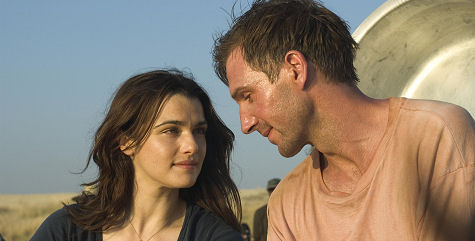
Rachel Weisz, Ralph Fiennes in fernando Meirelles’ The Constant Gardener
“In late February I was invited to a benefit showing of Gardener with the proceeds going to the Constant Gardener Charity, an organization established by the producers of the film to provide assistance in the form of schools, water tanks and other necessities to impoverished residents of Kibera, the sprawling slum located near the heart of both the city and the film. The main draw of this screening was the presence of Constant Gardener actor Pete Postlethwaite and producer Simon Channing.
“The screening and the reception afterwards were sponsored by the British High Commission, which seems a bit surreal given that the film is a stinging critique of British diplomacy, and one in which the British Foreign Ministry (particularly the BHC in Nairobi) is depicted as aiding and abetting evil. It’s a little like the U.S. Embassy sponsoring a showing of Fahrenheit 9/11.
“I wasn’t at this screening but I would have loved to ask British High Commissioner Adam Wood aif his bosses in London were anything like Bill Nighy’s character.
“I sponsored my own showing of the Gardener DVD at my house last January, with the aid of a borrowed LCD projector. The reviews from my guests, all diplomats and aid workers living in Nairobi, were mixed tending to negative.

Somewhere in this photo is the marquee of the former Cameo Cinema in downtown Nairobi
“The aid workers found the Weisz character profoundly annoying and embarrassingly naive, and the diplomats were unable to swallow the love story. I enjoyed the top-shelf acting talent and the visuals, but having read the book I was disappointed to see that hundreds of pages of plot had been excised, including much of the intrigue involving Big Pharma.
“I guess this is understandable given that Mereilles was trying to avoid a three hour-plus running time, but I thought that this removed much of the book’s suspense and jittery paranoia. Mereilles turned a page-turning global-conspiracy potboiler into an often plodding, reflective character study, perhaps on purpose. And this is coming from someone who was head-over-heels over City of God.
“My other problem with the film is that it falls too easily into the old Hollywood paradigms about Africa. As with movies like Cry Freedom or Out of Africa, the African experience is only palatable to Western audiences if filtered through a well-meaning white protagonist. Actual Africans are relegated to supporting roles with few lines, and are not allowed more than two dimensions: they must play one of four acceptable roles: the desperate victim, the noble martyr, the loyal servant or the corrupt official.
“In The Constant Gardener, which has no major African characters, the only African who really registered with me was the great Kenyan actor Sidede Onyulo (also terrific in Nowhere in Africa), who plays the jaded UN pilot and is gone from the story all too quickly.

“The only Western-produced movies I’ve seen recently in which fully-drawn, articulate, complex African characters are put at the center of their own stories are Dirty Pretty Things and Hotel Rwanda. (Okay, so Don Cheadle’s not exactly African and Chiwetel Ejiofor was born in London.)
“Hope all is well stateside. I’m still in shock over the Crash win. That film was shown on another one of our LCD projector movie-nights showings, and my wife and I couldn’t stand the thing. Much unintentional laughter was had at the expense of that movie’s clumsy dialogue and poorly-drawn characters. Maybe you have to be an Angeleno to appreciate it.” — Peter McKenzie, Nairobi, Kenya.
Different Enough?
There’s a slightly longer “Director’s Cut” DVD of Paul Haggis’s Oscar-winning Crash hitting stores on April 4th. It’s just about three minutes longer than the 112-minute version that played in theatres. Extra dabs, clips and brushstrokes “integrated,” as a Lionsgate spokesperson put it this morning.
The two-disc package will have several deleted scenes and the usual featurettes, etc., but it’s too bad the slightly altered film on the DVD won’t be a little more so. A good 15 or 20 minutes longer, say, or maybe even a Wyatt Earp-sized three-hour cut. All those racist Los Angelenos, all those story strands…why not?
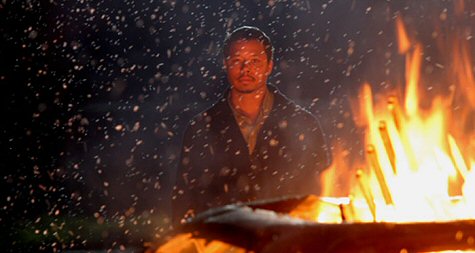
Terrence Howard
Or maybe a shorter, tighter version in the vein of Terrence Malick’s re-released version of The New World, maybe with substituted footage or all the same scenes but more streamlined. There’s no such thing as a film that can’t be just a wee bit improved with the right trims or reshufflings. I could go back to just about any article I’ve ever written and improve it with a few edits…easy.
I called Paul Haggis (through his publicist) to discuss the content of the extra stuff, but no callback. So I tried Bobby Moresco, who shared the Best Original Screen- play Oscar with Haggis two nights ago, and he didn’t get back either. I’m getting a distinct feeling that the 115-minute Crash doesn’t mean much in their world right now.
I get it…I do. Lionsgate suddenly has a Best Picture winner with brand-new earning potental so they’re trying to milk it every which way…fine. And I’m always up for a good milking if the package is right.
But if I’m a food critic and a chef says he’s got a whole new menu he’d like me to try, and it turns out the only thing different is that all the dishes have an extra spoonful of steamed carrots, I’m going to feel disappointed.
A special director’s cut of a well-liked movie means a rethink or a recall of some kind. It’s about having another go. My expectation when this happens is a juicier steak or extra mashed potatoes with gravy…something with calories.
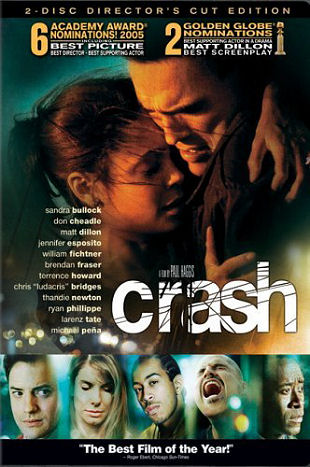
The final cover will obviously tout the Best Picture Oscar triumph — this one was roughed out a few weeks ago
I’m sure the extras on the double-disc Crash will be fine, but the film is the matter at hand.
Sidenote: In looking into this story I noticed that three credible sources — Variety, N.Y. Times and DVD Empire — give three different lengths of the original Crash.
Variety‘s Toronto Film Festival review (September 2004) said Haggis’s film ran 112 minutes, A.O. Scott’s 5.6.05 Times review said it runs 107 minutes, and DVD Empire claims a running time of 122 minutes.
Somebody at DVD Empire probably just hit a “2” key when he was aiming for the “1” but that N.Y. Times estimate is…well, odd.
Happiness
